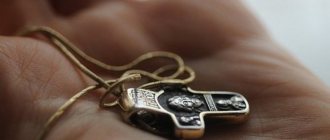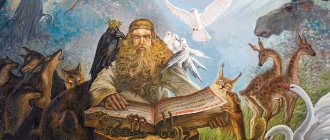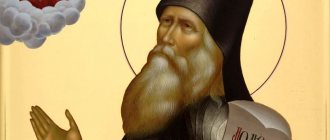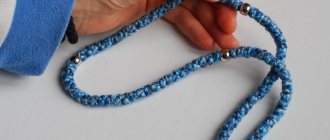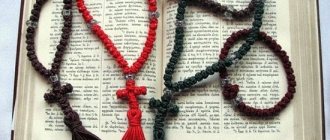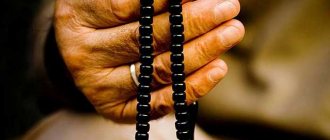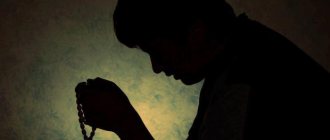Lestovka is a type of rosary, a type of rope, widespread in Ancient Russia and preserved in the everyday life of Old Believers. It is a woven leather (or, in later times, rag or leatherette) tape sewn in the form of a loop. It symbolizes both the ladder (ladder) of spiritual ascent from earth to heaven and a closed circle, an image of eternal and unceasing prayer. A ladder is used to make it easier to count prayers and bows, allowing you to focus on the prayers.
In addition to the usual 109-step ladder, there are 150-step ladders, the so-called. "Virgin's Ladders" They are of later origin and are made in the image of a Catholic rosary. In the Old Believers they have minimal distribution. The production and artistic decoration of ladders was and remains one of the traditional Old Believer crafts. Monastic work was especially famous.
Design and symbolism of the ladder
The device of the ladder meets the practical needs of worship (for example, when saying prayers 40 or 12 times), but at the same time it has a symbolic interpretation. There are 100 simple steps on the tape, called bobs. In addition, there are three more steps at the beginning, three at the end and three “great” steps in the middle, which collectively mean the nine ranks of angels . The beginning and end of the ladder are marked by intervals without steps, symbolizing heaven and earth . The “great” steps divide the staircase into four unequal sections: from the “ground” to the first great step - 12 steps, which means 12 apostles . From the first great step to the second inclusive - 40 steps. This means a 40-day fast of the Lord Jesus Christ . There are 33 steps to the third great step, meaning 33 years of the Lord’s earthly life . After the third great step and up to “heaven” there are 17 simple steps, meaning 17 Old Testament prophecies about Christ . At the junction of the ends of the ribbon, four edged triangular “lapostki” (laposka, sometimes palms) are sewn, which are often decorated with beads and embroidery. They mean the four evangelists , and the border is the gospel teaching . Under the paws there are slides - seven rectangles strung on a ribbon, according to the number of seven church sacraments . These movements also mean seven complete lestovkas, which every pious Christian must pray during the day. This practical significance of the movements - counting the number of sanded flaps - is absent in products of modern work, since the movements are made only symbolically, and the legs are often so tightly sewn together that the movements are difficult to reach.
LiveInternetLiveInternet
Quote from Zhanna_
Read in full In your quotation book or community!
about the ladder
Pronunciation : emphasis on the first syllable. , l é
stovka.
Origin of the word : diminutive of " ladder"
", i.e. stairs.
Brief definition : a type of rosary for counting prayers, a leather or cloth ribbon sewn in the form of a loop and having 109 " steps
"(otherwise known as "
bobs
"), divided into unequal groups.
Design and names of parts : 4 triangles are called paws
, must be sheathed.
movements
between the paws .
From the bundle there are three steps in a row on the tape, then a smooth section without “beans”, the so-called. “ simple place
”, then 12
small
or
simple
steps, one
large
or
great
, after it 38 small, again large, 33 small, large, 17 small, again a simple place and before the link again three steps.
Counting : along the ladder, simply count the numbers 3, 7 (7 movements), 9 (3 steps at the link, 3 large ones in the center and again 3 at the link), 12, 15 (3+12), 20 (17+3), 40 (38 small and two large steps), 50 (33+17), 100 (without large steps and steps at the ligament), 103 (on the vervitsa
Basil the Great, from whom the lestovka originated, had 103 knots), 109, etc.
Symbolic meaning : the ladder is closed in a ring as a sign of unceasing prayer and at the same time marks the ladder of spiritual ascent from earth to Heaven; the paw triangle is a symbol of the Holy Trinity; the number of paws means the number of evangelists, the trim of the paws means the gospel teaching; there are seven movements according to the number of church sacraments; three steps on each side of the bundle and three large steps make up the nine ranks of angels; simple places (without steps) at the beginning and end of the ladder mean earth and Heaven, respectively; 12 steps from the “earth” - 12 disciples of Christ; the next 38 steps mean 38 weeks that the Mother of God carried Christ in her womb, with two large steps on both sides they form 40 - according to the number of days of the 40-day fast of the Lord; 33 steps - the number of years lived on earth by the Lord; after the third big step to “Heaven” 17, according to the number of Old Testament prophecies about Christ, small steps.
Words similar in meaning : rope, rosary, rosary. Vervitsa, (i.e., a small rope) is a rope loop with knots from the Byzantine tradition. Rosary (from the word “to count”) is a cord with beads strung on it, used in the practice of many religions. The Rosary (i.e., a wreath of roses) is a special prayer to the Mother of God (Catholic) on a rosary and the rosary itself. The lestovka can be called a rosary (since prayers are counted by it), and a kind of rope (of which the lestovka is a direct descendant) and a rosary (especially in texts for Western readers); in addition, there is a (much later) “rosary ladder” with a different number of steps for the Mother of God rule.
Usage : Currently, this convenient, thoughtful and deeply symbolic traditional device for prayer in the Russian Orthodox Church has been completely replaced by the rosary. Lestovka is used only by Old Believers of almost all “concord” trends. Every Orthodox Christian Old Believer, not only a monk, but also a layman, should have his own ladder; everyone should constantly pray to the Lord. Just as the lestovka is adapted to the prayer rules, so the rules are coordinated with the lestovka: how many lestovkas need to be read in the morning or during the day, from what great level prostrations are replaced by bows from the waist, etc. Even for the deceased, a special pre-prepared (usually white) hand must be placed on the coffin ) ladder. The great Russian prayer book, St. Seraphim of Sarov, is traditionally depicted with a ladder in his hands.
An example of a prayer rule : 10 prayer rules are read. The first seven ladders with the Jesus Prayer:
Lord , Jesus Christ , Son of God , have mercy on me , a sinner _
eighth ladder to the Guardian Angel:
And the angel of Christ , my holy Guardian , saved my sinful servant _ _ _ _ _
ninth to John the Baptist:
Holy Great John , prophet and forerunner , Baptist of the Lord 's day , pray to God for me , a sinner
and the tenth to the Most Holy Theotokos:
Most Holy Lady God of God , I saved Thy sinful servant _ _ _ _
Each ladder is reprimanded in this way: the first three and last three steps are read
Allil u yah, Allil u yah, glory to you , O God
with bows to the ground. The first 12 and last 17 small steps are also bows to the ground, the remaining small steps are bows from the waist. On the first great step (after 12 small ones) with a bow to the ground they read:
Remember me , Lord , when you came to the kingdom of _ _
On the second great step with a bow to the ground:
Remember me , Vladyko , when I was in the kingdom _ _ _
On the third great with a bow to the ground
Remember me , Saints , when you were in the kingdom of _ _
At the end of the staircase
Lord have mercy _ _
(three times).
Glory to the Father and the Son and the Holy Spirit , now and ever and ever , amen . _
Pray without ceasing: an ancient Russian life hack
In Rus' they took very seriously the words of the Holy Scriptures about unceasing prayer. All life and everyday life were built around the daily liturgical circle. However, for obvious reasons, only a few ascetic monks could stand in prayer in church or at home before the image. A solution was found: the symbolic Russian mind reworked the experience of the Eastern fathers and created the lestovka - the famous domestic device for unceasing prayer.
In the “Flower Garden” of the holy monk Dorotheus there are the words: “Unceasing prayer, the Jesus Prayer and other spiritual deeds are worthy of all earthly things, deeds and speculations.” Nowadays, there is an erroneous opinion that the Jesus Prayer is the lot of priests and monks only. But that's not true. We are all called to constant dialogue with God, therefore we require perfect tools, tested by time and Christian ascetics. The Jesus Prayer keeps us afloat in the ocean of worldly vanity, does not allow us to fall into despair, gives inspiration, and brings to mind a brain that is torn to pieces.
The Jesus Prayer: Lord Jesus Christ, Son of God, have mercy on me, a sinner (a sinner) - has prototypes in the Gospel. Thus, blind Bartimaeus, upon Jesus’ exit from Jericho, shouted: “Jesus, Son of David! Have mercy on me." (Mark 10:47). The appearance of the Jesus Prayer is attributed to the instructions of Macarius of Egypt (IV century). Both in Byzantium and in Rus', performing this prayer was considered necessary for a Christian, be it a bishop or a layman. During the existence of the Church of Christ, quite a few treatises and explanations have been written about this “source of grace.” But it should be noted that the Jesus Prayer requires attention, prudence, reverence and repentance, that is, a serious approach.
Since we are corporeal beings, we need physical and material expressions of our faith: temples, icons, books, prayer objects. To perform the Jesus Prayer (and not only) in time immemorial, a rope was invented. This foremother of the Russian rosary was established by Vasily the Great. In Rus', it turned into a lestovka, acquired edifying symbolism and has survived to this day.
The word "ladder" is a diminutive of "ladder". Russian rosaries received this name because of their appearance. The ladder consists of bobbins (birch rounded planks) sewn into leather, which resemble a flexible ladder. The prayer object begins and ends with four triangles sewn together on both sides - paws (petals). They symbolize the four evangelists and the unity of their teaching. The triangular shape is installed in honor of the Holy Trinity. Inside the paws, as if in a small bell, 7 movements are sewn on the “tongue”, according to the number of church sacraments. They are used to count the number of “passed” ladders. It is customary to hold the lestovka in the left hand, between the middle and ring fingers, and move it with the thumb. On the first three bean-shaped steps, the prayer “Alleluia, alleluia, alleluia, glory to Thee, O God” is read with a bow from the waist. Next comes the free space called “ground.” At this point the person praying says “Glory to the Father, and the Son, and the Holy Spirit.” And then he moves on to the beans with the Jesus Prayer. It is worth noting that when making ladders, craftsmen, as a rule, insert into the steps a small piece of paper with the Jesus Prayer handwritten on it.
Before the person praying there are 12 Jesus prayers. They are recommended to be performed with a bow to the ground (if the prayer is performed in front of the image, about which later). This “row” symbolizes the 12 apostles, “who walked the earth with Christ.” Then the “great” step awaits the worshiper with the prayer “Remember me, Lord, when you come to the Kingdom of Si” and a bow to the ground. And again - the Jesus Prayer with bows from the waist, 38 times. Here “forest theology” reminds us that “The Mother of God carried Christ in her womb for 38 weeks.” Then follows the second “great” step - “Remember me, Lord, when you come to the Kingdom of Xi.” After this prayer with bows from the waist, 33 more - Christ “walked on the earth” for 33 years. The “Great” “Remember me, O Holy One, when you come to the Kingdom” and the 17 prayers of Jesus with prostration remind us of the number of Old Testament prophecies about Christ. We find ourselves in a free place called “heaven”, we say the prayer Glory, And now, three times “Alleluia, alleluia, alleluia, glory to Thee, O God.” That's the end of the ladder. At the end of it, “Lord, have mercy” and Glory and Now are read 3 times.
“Lestovka arose at a time when there were very few books, video lectures and podcasts were absent. Therefore, a lot had to be explained visually. And the symbolic device itself is a good reminder for a Christian.”
This scheme may seem complicated to some, but it is mastered very quickly, and, as will become clear later, the ladder is applicable in a variety of situations, including during worship. For example, the first 12 steps to the big one or from the same first “great” to the second (40) are very helpful in not bending your fingers during the “Lord, have mercy” required at the service, but in fingering the ladder with your fingers and concentrating on prayer. For some, the symbolism of the ladder sometimes seems wild and unnecessary. But to understand why it is, it is worth remembering that lestovka arose at a time when there were very few books, video lectures and podcasts were absent. Therefore, a lot had to be explained visually. And the symbolic device itself is a good reminder for a Christian. By the way, Seraphim of Sarov is depicted with a ladder on many icons, and more recently the production of Russian rosaries has been taken up quite seriously in Valaam.
In the “Charter on Home Prayer,” it is proposed in some detail, due to infirmity, illiteracy, or circumstances leading to absence from church for services, to replace the entire liturgical circle with the reading of prayers according to the ladder. And here there are also variations: without bowing (which also involves prayer while doing some business or simply physically moving in space), with bowing, and in the most simplified version for sick people. Let's turn to the statutory instructions.
The rule of prayer on the ladder without bowing:
- For the Midnight Office: six hundred prayers.
- For Matins: one and a half thousand.
- For non-hourly hours: one thousand; hourly: one and a half thousand.
- For Vespers: six hundred.
- For the great non-miphon: seven hundred.
- For Little Vespers: four hundred.
And with bows:
- For Vespers: three hundred bows.
- For non-miphon: three hundred bows.
- For the vespers: two hundred bows.
- For the Midnight Office: three hundred bows.
- For Matins: seven hundred bows.
- For the first hour: one hundred and fifty bows.
- For hours: five hundred bows; for hourly hours: seven hundred and fifty bows.
Despite the fact that above we considered options with bows to the ground and from the waist, the charter says that all bows are from the waist. The addition of earthly “deeds” is at the discretion of the person praying. At the 38th and 33rd steps they could also add prayers to the Mother of God and other saints, at the discretion of those praying. Or to everyone at once: “All saints, pray to God for me, a sinner.”
There are also very simplified rules:
- For Vespers: two hundred bows.
- For Vespers: one hundred bows.
- For the Midnight Office: two hundred bows.
- For Matins: four hundred bows.
- In the first hour: one hundred bows.
- In hours: three hundred bows.
And in case of “extreme need” (illness, time, other circumstances):
- For Vespers: one hundred bows.
- For Vespers: fifty bows.
- For Matins: two hundred bows.
- For the first hour: fifty bows.
- In hours: two hundred bows.
Lestovka could replace the reading of the Psalter. Let's look again at the statute.
- For the entire psalter: six thousand prayers of Jesus.
- For kathisma: three hundred prayers.
- For glory: one hundred prayers.
It would be worth mentioning separately about the ancient Russian practice of preparing for Communion using a ladder. The custom of rare communion came to Rus' from Byzantium. This was most likely due to a high level of piety... and difficult preparation. Anyone wishing to receive communion had to fast for a week (!) and read the Correct Canons. In their absence, it was proposed to pray 10 lestovkas daily, 3 of them completely with prostrations. Due to weakness, it was allowed to reduce their number to 7. However, even this, today, not all of us, contemporaries, will be able to do.
As we see, in Rus' (and today among Old Believers, co-religionists and a number of Orthodox Christians), the lestovka, despite its compactness, becomes a truly universal “prayer shield”. You can make a “weapon against adversaries” yourself; all materials are freely available.
Lent is a wonderful time to immerse yourself in the clear waters of prayer. The Holy Fathers call prayer a matter of deeds, but for us it becomes “our daily bread,” without which it is simply impossible to imagine a Christian. The tradition of prayer along the ladder is beginning to be revived these days, and, hopefully, will become useful to us, modern Christians.
You can applaud the author (at least 10 times)10
LESTOVKA - YOUR STEPS TO GOD
For more than 20 years, we, spouses Andrei and Natalia Golchenko, have been working in the field of reviving the ancient Russian tradition of weaving leather rosaries - Lestovka. After years of our work, we can happily note that interest in Russian spiritual traditions has increased not only in our country, but also beyond its borders! Taking as a basis the rosary-rosary on the lifetime portrait of Father Seraphim from the museum, we found convenient forms of such rosary of 10, 30, 50, 100 and 150 steps, divided into “tens”, which were convenient for reading the Mother of God rule on the Kanavka and not only loved by modern Orthodox Christians, but also correspond to all the canons familiar to them. This is how the “Diveyevo Lestovka” was born with its divisions into “steps” (instead of the Old Believer name - “bobochki”), which is now a model for many followers of this previously almost forgotten craft. To distinguish the Diveyevo lestovka from the ancient Russian Old Believer one with 109 bobochki, in addition to dividing into “tens”, we decided to put in each step a tightly rolled scroll with the written Jesus Prayer, and in the paws, a triangle with an embroidered Calvary cross, a piece of land from the Canal of the Most Holy Theotokos, our Diveyevo shrine. In our time, the Diveyevo staircase has firmly taken its place in the everyday life of modern Christians and we are glad that our labors and efforts were not in vain! Nowadays, the first thing that comes to mind when mentioning the Diveyevo staircase is Father Seraphim. People even got the name “Seraphim’s Lestovka”, which suggests that the Diveyevo Lestovka has taken on a life of its own! Diveyevo pilgrims remember what a blessed feeling it is to walk along the Canal of the Queen of Heaven with a rosary in their hands, reading the prayer “Virgin Mother of God, Rejoice!” 150 times. Especially in the evening, when all the worries of the day subside, silence sets in, and the sky becomes closer to the ground. Worshipers walk slowly along the Kanavka, fingering their rosaries, and all around it is as if it is no longer our hectic age, but ancient Holy Rus', which came here from the depths of centuries. After all, the ladder, in comparison with rosary beads, is very symbolic and in its essence most accurately reflects the symbol of our spiritual life: mentally climbing the steps of the closed circle of the ladder “from earth to heaven,” we get used to constant prayer, learn to keep our mind focused and don’t forget about God, don’t forget that we came into this world to improve ourselves spiritually. Our cherished dream and goal of our work is the return of the ancient Russian tradition, when every Orthodox Christian necessarily had his own ladder - his own “Stairway to Heaven”!

